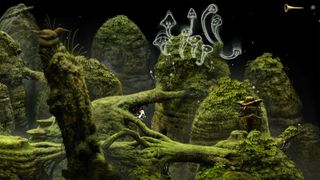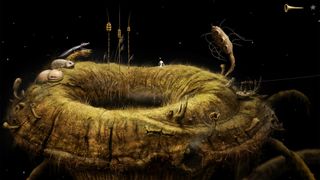Surreal wonderment and sheer weirdness: You should be playing Samorost 3
I can't imagine how difficult it must be to devise the puzzles in an adventure game. As a player, you want to be given tasks that are intriguing but not being overly complex; mentally stimulating without ever veering into the badlands of frustration. If the solutions are too easy or rudimentary, we're dissatisfied; too hard or illogical, and we'll readily bail to an online FAQ or stop playing altogether. Striking that balance seems nigh impossible, but that's the brilliance of Samorost 3: it effortlessly walks the line between obvious and obtuse puzzle solutions. As an artistic vision of a strange universe, and as a satisfying, pleasantly paced brain teaser, it's pretty much perfect.
There's not a single line of text in Samorost's story; the plot is set up by the delightfully odd illustrations of a picture book, menus and instructions are all handled with simple iconography, and dialogue is conveyed via evocative gibberish or charming exclamations like "Wahoo!" You play as an adorable, pajamas-clad boy, who wakes up one day to find a magical horn has landed in his front yard. What follows is an interplanetary journey to discover the horn's purpose, taking you from one bizarre-looking planet to the next without ever making you backtrack for puzzle solutions.

You don't have to have played the first two Samorost games to enjoy this one, though they come highly recommended. Everything Amanita Designs does is excellent; you probably know the indie studio's work from 2009's Machinarium, with its rusted metropolis full of quirky, charismatic robots. The overall tone of the Samorost saga is similar, in that it infuses lighthearted whimsy into an adventure of fairly epic scale - but compared to the lived-in feel of Machinarium's megacity, Samorost 3 is more about exploring the sometimes lonely unknown across a solar system of strange, deeply alien planets. It's also downright weird, involving encounters with mushroom spirits, sweetly singing termites, and a strange creature that can only blurt out "A-HOY!"
Amanita's trademark is the uncanny ability to paint beautiful, outlandish backdrops composited from bits of everyday objects, and the Samorost series draws from textures found in nature. Simply gazing at some of Samorost 3's landscapes can evoke the fuzzy feeling of moss, the cold smoothness of stone, the roughness of coral, or the straw-like strands of a coconut shell. You'll immediately want to poke around the environments with clicks of your mouse (iOS and Android versions are coming soon) just to see how it reacts, which plays into the fact that all the puzzle solutions blossom out of interactions with your surroundings. If ever you get stuck, the built-in hint system can always get you going again, though the enchanted book containing all the solutions Is just tricky enough to open that you might rethink your need for a nudge forward, and decide to deduce the answer for yourself.

There's also a beautiful musicality that drives your progress throughout Samorost 3. Your mythical horn acts as both a listening device and a ethereal clarinet for some call-and-response bits of melody hiding in the world. The rewards for optional puzzles and little Easter eggs scattered across each planetoid are simple rhythms, which all add up to an increasingly funky melody once you've collected enough 'records' to spin. If you were fond of Machinarium's musical interlude with the trio of robot street performers, you'll love the many 'harmonizing the band' moments on offer here.
It's all well worth experiencing for yourself. With its fantastical habitats and finely tuned challenge, Samorost 3 can be enjoyed by anyone, no matter their age or experience with the point-and-click adventure game genre. At around five or six hours, it's like the gaming equivalent of a beloved children's book: relatively short, sweet, and begging to be played through all over again whenever the mood strikes you.
Sign up to the 12DOVE Newsletter
Weekly digests, tales from the communities you love, and more
Lucas Sullivan is the former US Managing Editor of 12DOVE. Lucas spent seven years working for GR, starting as an Associate Editor in 2012 before climbing the ranks. He left us in 2019 to pursue a career path on the other side of the fence, joining 2K Games as a Global Content Manager. Lucas doesn't get to write about games like Borderlands and Mafia anymore, but he does get to help make and market them.
Most Popular



